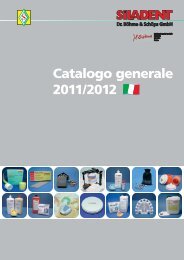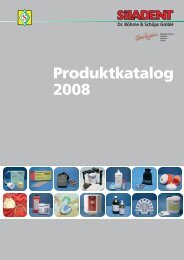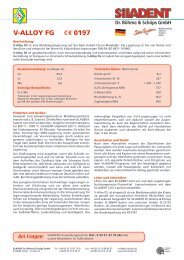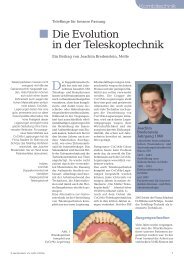Product catalogue 2012 - SILADENT Dr. Böhme & Schöps GmbH
Product catalogue 2012 - SILADENT Dr. Böhme & Schöps GmbH
Product catalogue 2012 - SILADENT Dr. Böhme & Schöps GmbH
Create successful ePaper yourself
Turn your PDF publications into a flip-book with our unique Google optimized e-Paper software.
Mixing<br />
Mixing in a vacuum mixer generally<br />
has a positive effect on the<br />
gypsum. When mixing mechanically<br />
in a vacuum, you will need<br />
only half the time quoted for<br />
manual mixing, i.e. 60 seconds<br />
mixing by hand equals 30 seconds<br />
mixing by machine.<br />
4 5 6<br />
gypsum crystal structure.<br />
You should never add more<br />
gypsum powder to an excessively<br />
thin mix or more water to<br />
an excessively thick mix. You will<br />
only be interfering in the setting<br />
process and will damage the<br />
Surface problems<br />
Difficulties with the surface bet-<br />
ween the gypsum and alginate or<br />
hydrocolloidal moulding materials<br />
can be overcome by pretreatment<br />
of the mould. Alginate<br />
impressions can be neutralized<br />
with trimming water of gypsum<br />
powder and insulated with alginate<br />
insulant to prevent blooming<br />
or unhardened areas in<br />
the surface of the model. Hydrocolloidal<br />
impressions should be<br />
replaced in potassium sulphate<br />
or potassium carbonate solution<br />
and neutralized.<br />
9 10<br />
Carefully remove saliva and<br />
blood remnants, as they will also<br />
impair a dental gypsum setting<br />
properties.<br />
The finish<br />
mixture must<br />
be transfered<br />
immediately<br />
to the mould.<br />
Casting<br />
Never mix more gypsum at the<br />
time than you will need for 2-3<br />
impressions because the mould<br />
must be filled within the processing<br />
time. During the crystal<br />
forming process, which starts at<br />
the end of the processing time,<br />
the gypsum must be left alone.<br />
If you work with a gypsum that<br />
has started to solidify, the fine<br />
details will not be reproduced<br />
with enough accuracy and the<br />
strength of the gypsum will be<br />
reduced notably.<br />
This point must be observed<br />
particularly if you use vibrator.<br />
Filling the mould on a vibrator<br />
certainly has a positive impact on<br />
the formation of bubbles, pressure<br />
resistance and fluidity, but<br />
the vibrating must never be continued<br />
into the setting time.<br />
Soaking the model<br />
Gypsum casts should never be<br />
subjected to shock treatment. If<br />
a cast needs to be evaporated for<br />
example, soaking (for approx.<br />
5-8 minutes) will reduce the risk<br />
of the model being affected by<br />
flaking and cracking. Cleaning<br />
with a stream lance may remove<br />
surface layers and lead to inaccurate<br />
contours. Models are<br />
10 rules to be observed<br />
Modelling time<br />
If the gypsum loses its lustre, it<br />
is possible to model or trim the<br />
gypsum for about 60 seconds.<br />
The subsequent setting time<br />
varies from one grade of the<br />
gypsum to another. We fix a setting<br />
time of approx. 10-12 minutes<br />
+/- 1,5 minutes for hard stone<br />
(type 3). Some super hard stone,<br />
on the other hand, are tuned for<br />
longer overall setting times. Setting<br />
times in accordance with a<br />
customer‘s individual wishes are<br />
possible for large orders. The<br />
gypsum must not be processed in<br />
any way during the setting time.<br />
best cleaned with a soft brush<br />
and a mild soap solution. Brief<br />
soaking may also prevent flaking<br />
and spalling when old models<br />
are being sawn or prepared. In<br />
order to prevent surface erosion,<br />
the water can be saturated with<br />
calcium sulphate, for example by<br />
inserting old models.<br />
9









